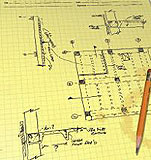
Practical Design: A Supplement to Academics
A series of articles published in "Concrete International" focuses on bridging the gap between academics and the design workplace. Authors Emily B. Lorenz, engineering editor for "
Concrete International," and Amy Reineke Trygestad, Central US Regional structural engineer for the Portland Cement Association (PCA), stated, “In an ideal world, design firms could expect new graduates to be productive from day one. In reality, many new graduates have had exposure to only a few structural design courses. In fact, some may take only an introductory course that combines structural steel and reinforced concrete design. Many won’t take advanced design courses and, thus, may be unfamiliar with terms such as “two-way slab,” “pan-and-joist,” or “lateral design".
 Those who do take advanced coursework may have been introduced to modern structural design software. Although software can be a great tool for conducting case studies in order to develop a better understanding of system behavior, it also can create additional challenges for instructors. In particular, software has limited value if the student learns only to be proficient using it, without necessarily gaining a basic understanding of the theory behind the computer code. Without that understanding, “Garbage In, Garbage Out” (GIGO) applies all too well.
Those who do take advanced coursework may have been introduced to modern structural design software. Although software can be a great tool for conducting case studies in order to develop a better understanding of system behavior, it also can create additional challenges for instructors. In particular, software has limited value if the student learns only to be proficient using it, without necessarily gaining a basic understanding of the theory behind the computer code. Without that understanding, “Garbage In, Garbage Out” (GIGO) applies all too well.
The new engineer requires mentoring. Unfortunately, in the fast-paced world of design and construction, with the conflicting demands of tight fees and ever-evolving, complex code requirements, it’s difficult for seasoned engineers to find the time for mentoring. […] The mentor-apprentice relationship has no substitute, [but] this series of articles will bridge a few gaps and help to make the transition from academic life to professional life a little smoother.”
Following are reprints of the articles by Lorenz and Reineke Trygestad: